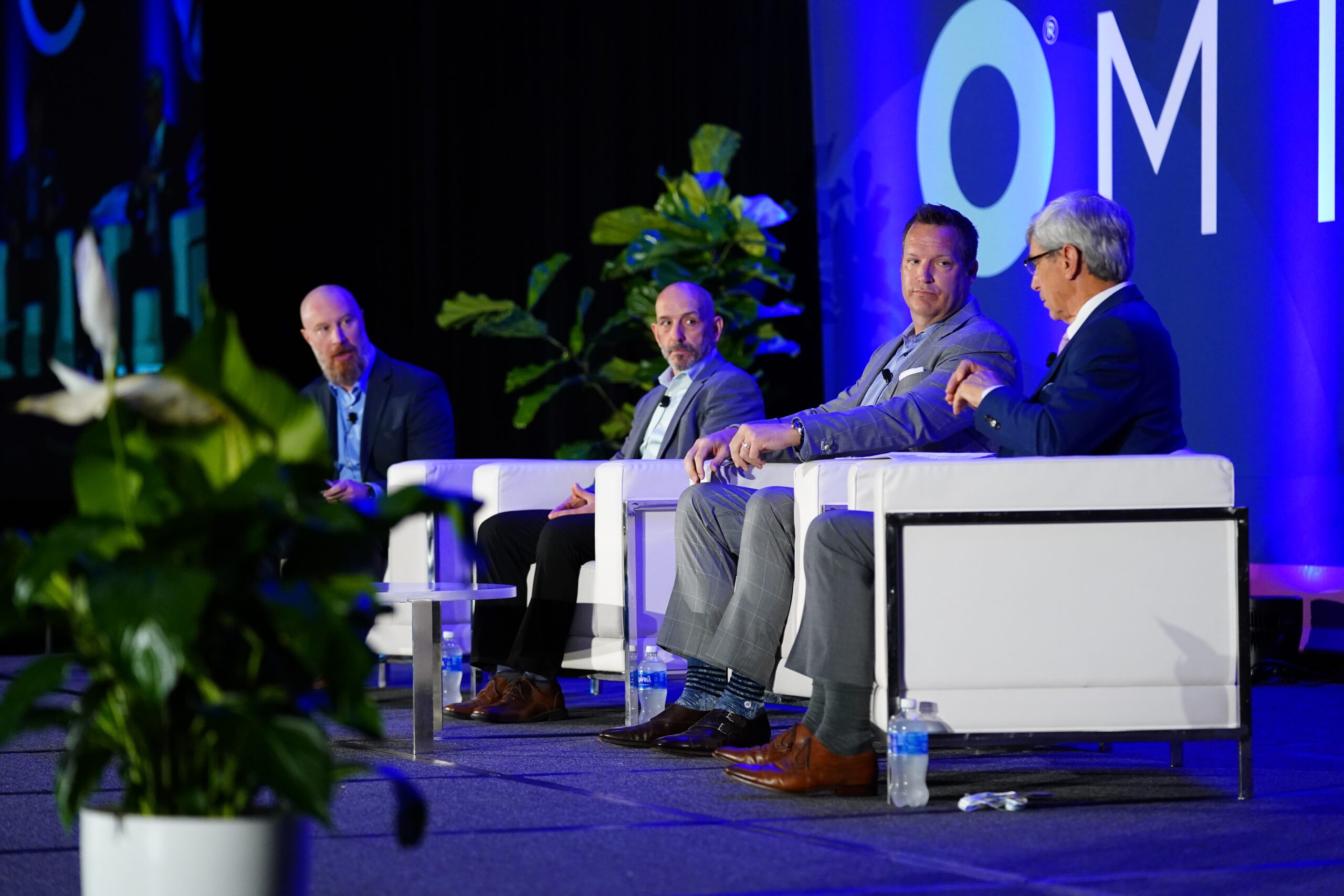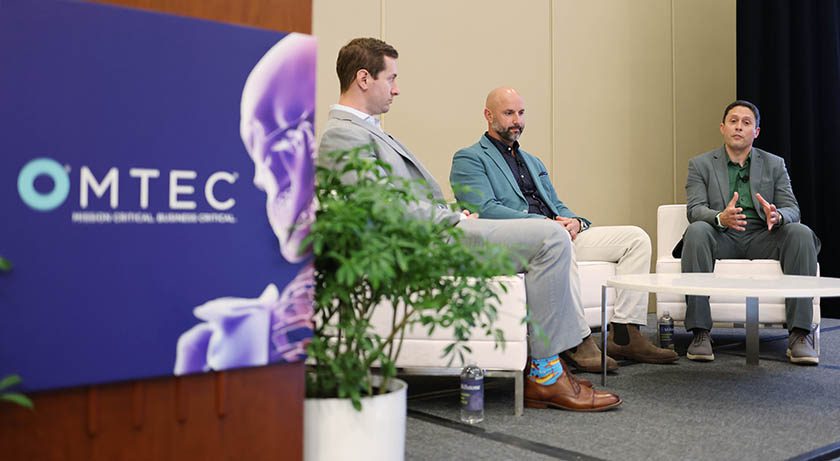

 Copy to clipboard
Copy to clipboard 
Lee D. Hieb, M.D., is a Board Certified Orthopaedic Surgeon specializing in Spinal Surgery. Following medical school, she completed an Orthopaedic Residency in the U.S. Navy and served as a general Orthopaedic Surgeon with the U.S. Marine Corps.
Dr. Hieb has been in private practice for over 20 years, and this experience has compelled her to share her views on healthcare reform and the growing bureaucratic nature of the government and its programs. She is immediate past president of the Association of American Physicians and Surgeons. Now semi-retired, Dr. Hieb divides her time between an orthopaedic practice in Iowa, chicken raising and caring for her husband and two sons.
The following echoes the sentiments of Dr. Hieb’s recent keynote address at OMTEC 2012, entitled “Orthopaedics and the Vampire Economy.”
American medicine today is truly in crisis, but not for the reasons most often reported.
Those who generally believe in government solutions cite a need to improve quality, to provide access to care for everyone and to decrease cost. Government, with its inevitable over-regulation, does not solve these problems, but makes them worse.
Since the 1965 implementation of Medicare and Medicaid, the Federal government has written over 150,000 pages of regulation that increase the cost of practicing medicine, squander the energies of highly trained professionals whose time is now spent in compliance and often directly and negatively impact quality care. This negative result is not limited to the minority of Americans the government set out to help, but impacts all of them, inside and outside the Medicare umbrella. Government “health care” exemplifies Ronald Reagan’s aphorism, that “When government is the problem, more government is not the answer.”
By way of illustration, consider the case of Doppler Ultrasound. This is a 20-some-year- old test performed to diagnose blood clots in the legs. Until last year, this procedure cost $235 and took under an hour to perform and deliver the result to the doctor. Enter an unelected government bureaucrat (or to use a newly coined term, “Medicrat”), who decided that the same technicians who have been performing this study for years now need additional certification—a certification that takes two years to obtain—essentially ensuring that hospitals must hire a new, generally less-experienced graduate.
Of course, since market forces did not demand more techs, there are not that many new grads being produced, so many hospitals cannot hire one, and smaller hospitals may not easily afford a second ultrasound tech. As a result of this one requirement, small hospitals all across America have become unable to perform this simple test in their own radiology departments.
Today, to get care for their patients, providers must spend time calling around to find a hospital that can do the test. Then, the patient must be bundled into an ambulance without any doctor or nurse in attendance. (God help them if they are terribly ill, which some of these patients are.) Patients are driven to another hospital where they may lie around in a radiology suite for hours, and are then finally returned to their hospital of origin. With luck, the results can be called to the doctor within eight hours and the patient survives the ordeal.
As for quality care…forget it. If it hasn’t happened yet, it is only a matter of time before someone dies as a result of this gross delay in care, and the ambulance-ride-to-hell-and-back. In fact, some hospitals are so worried about this gross breach in quality that they are practicing civil disobedience, pretending ignorance of the regulation. In doing so, they are risking their own certifications to stay open as hospitals rather than risk the lives of their patients.
Cost? This one regulation has multiplied the cost by 15 to 20 times by adding the cost of an ambulance ride (in my rural area, this amounts to $3,000-$4,000) to a $235 test.
But what about access? Clearly it has decreased access for Medicare patients, but what about the insured? Suppose Bill Gates were traveling through the wilds of Iowa and ended up in my hospital with a swollen leg. He offers to donate a million dollars to our hospital if we will just do the test and not ship him elsewhere. Sorry, Bill. We can’t do cash-pay patients. We can’t do insured patients. We can’t even do the uninsured that the government purports to care so much about. According to the Health and Human Services representative we contacted, that would be “discriminatory” against Medicare patients.
So it goes, day in and day out, in every aspect of today’s government medicine. The bloated Medicare bureaucracy has wreaked havoc upon a once honorable profession and has brought medical care in America to the brink of disaster.
Doctors are retiring at the first economic opportunity. We have a critical shortage of specialists. There are, for example, only 12,000 oncologists in the entire country in spite of a growing and aging population, and we are producing only 300 general surgeons a year. Young med school graduates are trained to be shift workers, transferring patient care to hospitalists and other lower level “extenders.” Hospitals cannot stay afloat in locales most in need. And, for the first time in my 30+ years in medicine, we are short of critical supplies—things such as Valium and tetanus toxoid, certain catheters, Propafol for anesthesia and common antibiotics such as Levaquin, to name a few.
The solution seems to elude our public officials, but is really not complicated. It involves the three Cs: Cash, Catastrophic Insurance and Charity.
Cash
Cash for outpatient and “small ticket” items keeps cost down through free market competition and through decreasing medical office overhead. In my previous private practice, I employed seven people, five of whom were necessary only to deal with 3rd-party billing. If patients had paid cash at the front window, I could have functioned with two employees—a significant decrease in my overhead.
Secondly, a doctor cannot overcharge the patient who pays cash because the patient can find some other doctor with better cash prices. In contrast, prices continue to rise in the Medicare monopoly that fixes the price for everyone.
Cash at the window gets rid of fraud. A physician, no matter how unscrupulous, cannot defraud the guy at the front desk and charge him for services not rendered because the patient knows directly what was done to him. Nor does the physician have to dictate a three-page note to convince Medicare or an insurance company that he did what he claimed on the billing form. (This returns doctors to the bedside and away from the computer screen.)
Finally, doctors would not have to fear criminal prosecution for choosing an “incorrect” code out of the mammoth Medicare required code book for office procedures.
Catastrophic Insurance
Catastrophic insurance is not new. It is the way your car and house insurance policies work. You don’t use them for every little repair on your house or car, and truly you hope never to have to use these insurance policies at all.
Catastrophic insurance is meant to protect you from truly “catastrophic” financial loss. When your roof blows off, you call your insurance agent. When a shingle blows off, you take out your wallet.
Unfortunately today in medicine, we buy health insurance expecting it to cover every little runny nose or well-child exam. Of course an actuary, the person who can tabulate the risk this year of your roof blowing off, cannot know how many times you will visit a doctor for preventative care. So, true “insurance” becomes “pre-paid health care”—a very different and unpredictable product that inevitably results in a wild spiral of over-utilization, followed by price increases, followed by more use “to get my money’s worth.”
We need health insurance to operate like our car and home insurance. It should only cover the big expenses and we take care of the rest with cash. With this type of insurance you wouldn’t need a “Patient’s Bill of Rights,” since you, not your employer, are the customer and are treated as such. You wouldn’t need portability legislation, because you, not your employer, own the insurance policy. And the cost of private insurance with a high deductible is generally half as expensive as employee-based low deductible insurance.
Charity
The third “C” is charity. Americans are historically charitable. But government medicine is not charitable. It is predicated on theft, where you put a gun to your neighbor’s head and force him to pay for someone else’s medical care. Charity is when you reach into your own pocket, and for centuries Americans did so.
Before Medicare, in the 1950s and ‘60s, my father was a Marcus Welby-type small town country doctor. In those days, people were not dying in the streets for lack of care. Those who really needed assistance and could not afford it were helped by their friends, their families, their neighbors, community organizations, churches and the doctors who cared for them.
Those who received such aid saw it as charity—not an “entitlement”—and were grateful, not taking advantage of those who offered the help. Local charity is vastly cheaper than government largesse, which diffuses tax dollars into a ponderous bureaucracy before doling out the meager leavings. And, if cash were the basis of outpatient care, and catastrophic insurance the basis of inpatient care, all costs would lessen and it would be cheaper to care for those truly in need.
A Fourth C
In truth, there really is a fourth C: Compassion. Compassion is intrinsic to the art of “medicine,” but plays no role in the government delivery of “health care.”
Physicians aren’t born with compassion, but develop it as they come to know and care about their patients as individuals. Federal regulators who decide your care from 3,000 miles away have no compassion, because they have no personal relationship to you.
Government health care by its very nature is impersonal. Government, in all departments, must make choices in what it funds. When dealing with aircraft, procurement defunding means the death of a production line. But in government medicine, where people have no private choices, defunding a disease or procedure means the literal death of patients.
No Medicare or insurance reviewer wants to face the fact that denying care can lead to death. To make such a job tolerable, those denied care must be depersonalized. To the officials making health care decisions at a distance, patients are known by their medical record numbers and their diagnostic codes. You become a “covered life” and ICD-9 802.1, not Mary Jones.
It is no accident that the Jews were given numbers and robbed of all personal identity before being killed. It is no accident that in 1938, the decision for euthanasia was taken out of the hands of the victims’ local physicians and placed into the hands of a distant committee. The British National Health Service, which has condemned many people to premature death through denial or delay of care, is so impersonal that at one point, they attempted bar coding patients.
Ultimately, there is always more potential medical care that people may want vs. what they or any group can afford. The issue is, who makes the choice?
Rather than being told by some desk sitter in D.C. that my care is not deemed “medically necessary,” I prefer discussing my options with a personal, compassionate physician who knows me, cares about me personally and who can discuss with me the pros and cons, options and relative costs of treatments. Paying him cash means he works for me, not the 3rd-party payer, and with decreased paperwork he now has the time to spend with me to optimize my health needs.
Government pundits love to talk of prevention, but most real prevention comes not from your doctor, but from making better lifestyle choices. The traditional role, the real reason for medical care is to treat disease. And disease is not just illness from germs. It is literally “dis-ease,” that is, the alleviation of suffering.
Government, massive and computerized, will never provide a sympathetic ear, a caring touch or any compassion for suffering. Returning to a system of cash payments, catastrophic insurance and charity will return doctors and nurses to the patient bedside, allowing them to practice the “art,” not just the Medicare-prescribed algorithm of medicine.
Lee D. Hieb, M.D., is a Board Certified Orthopaedic Surgeon specializing in Spinal Surgery. Following medical school, she completed an Orthopaedic Residency in the U.S. Navy and served as a general Orthopaedic Surgeon with the U.S. Marine Corps.
Dr. Hieb has been in private practice for over 20 years, and this experience has compelled her to...
Lee D. Hieb, M.D., is a Board Certified Orthopaedic Surgeon specializing in Spinal Surgery. Following medical school, she completed an Orthopaedic Residency in the U.S. Navy and served as a general Orthopaedic Surgeon with the U.S. Marine Corps.
Dr. Hieb has been in private practice for over 20 years, and this experience has compelled her to share her views on healthcare reform and the growing bureaucratic nature of the government and its programs. She is immediate past president of the Association of American Physicians and Surgeons. Now semi-retired, Dr. Hieb divides her time between an orthopaedic practice in Iowa, chicken raising and caring for her husband and two sons.
The following echoes the sentiments of Dr. Hieb’s recent keynote address at OMTEC 2012, entitled “Orthopaedics and the Vampire Economy.”
American medicine today is truly in crisis, but not for the reasons most often reported.
Those who generally believe in government solutions cite a need to improve quality, to provide access to care for everyone and to decrease cost. Government, with its inevitable over-regulation, does not solve these problems, but makes them worse.
Since the 1965 implementation of Medicare and Medicaid, the Federal government has written over 150,000 pages of regulation that increase the cost of practicing medicine, squander the energies of highly trained professionals whose time is now spent in compliance and often directly and negatively impact quality care. This negative result is not limited to the minority of Americans the government set out to help, but impacts all of them, inside and outside the Medicare umbrella. Government “health care” exemplifies Ronald Reagan’s aphorism, that “When government is the problem, more government is not the answer.”
By way of illustration, consider the case of Doppler Ultrasound. This is a 20-some-year- old test performed to diagnose blood clots in the legs. Until last year, this procedure cost $235 and took under an hour to perform and deliver the result to the doctor. Enter an unelected government bureaucrat (or to use a newly coined term, “Medicrat”), who decided that the same technicians who have been performing this study for years now need additional certification—a certification that takes two years to obtain—essentially ensuring that hospitals must hire a new, generally less-experienced graduate.
Of course, since market forces did not demand more techs, there are not that many new grads being produced, so many hospitals cannot hire one, and smaller hospitals may not easily afford a second ultrasound tech. As a result of this one requirement, small hospitals all across America have become unable to perform this simple test in their own radiology departments.
Today, to get care for their patients, providers must spend time calling around to find a hospital that can do the test. Then, the patient must be bundled into an ambulance without any doctor or nurse in attendance. (God help them if they are terribly ill, which some of these patients are.) Patients are driven to another hospital where they may lie around in a radiology suite for hours, and are then finally returned to their hospital of origin. With luck, the results can be called to the doctor within eight hours and the patient survives the ordeal.
As for quality care…forget it. If it hasn’t happened yet, it is only a matter of time before someone dies as a result of this gross delay in care, and the ambulance-ride-to-hell-and-back. In fact, some hospitals are so worried about this gross breach in quality that they are practicing civil disobedience, pretending ignorance of the regulation. In doing so, they are risking their own certifications to stay open as hospitals rather than risk the lives of their patients.
Cost? This one regulation has multiplied the cost by 15 to 20 times by adding the cost of an ambulance ride (in my rural area, this amounts to $3,000-$4,000) to a $235 test.
But what about access? Clearly it has decreased access for Medicare patients, but what about the insured? Suppose Bill Gates were traveling through the wilds of Iowa and ended up in my hospital with a swollen leg. He offers to donate a million dollars to our hospital if we will just do the test and not ship him elsewhere. Sorry, Bill. We can’t do cash-pay patients. We can’t do insured patients. We can’t even do the uninsured that the government purports to care so much about. According to the Health and Human Services representative we contacted, that would be “discriminatory” against Medicare patients.
So it goes, day in and day out, in every aspect of today’s government medicine. The bloated Medicare bureaucracy has wreaked havoc upon a once honorable profession and has brought medical care in America to the brink of disaster.
Doctors are retiring at the first economic opportunity. We have a critical shortage of specialists. There are, for example, only 12,000 oncologists in the entire country in spite of a growing and aging population, and we are producing only 300 general surgeons a year. Young med school graduates are trained to be shift workers, transferring patient care to hospitalists and other lower level “extenders.” Hospitals cannot stay afloat in locales most in need. And, for the first time in my 30+ years in medicine, we are short of critical supplies—things such as Valium and tetanus toxoid, certain catheters, Propafol for anesthesia and common antibiotics such as Levaquin, to name a few.
The solution seems to elude our public officials, but is really not complicated. It involves the three Cs: Cash, Catastrophic Insurance and Charity.
Cash
Cash for outpatient and “small ticket” items keeps cost down through free market competition and through decreasing medical office overhead. In my previous private practice, I employed seven people, five of whom were necessary only to deal with 3rd-party billing. If patients had paid cash at the front window, I could have functioned with two employees—a significant decrease in my overhead.
Secondly, a doctor cannot overcharge the patient who pays cash because the patient can find some other doctor with better cash prices. In contrast, prices continue to rise in the Medicare monopoly that fixes the price for everyone.
Cash at the window gets rid of fraud. A physician, no matter how unscrupulous, cannot defraud the guy at the front desk and charge him for services not rendered because the patient knows directly what was done to him. Nor does the physician have to dictate a three-page note to convince Medicare or an insurance company that he did what he claimed on the billing form. (This returns doctors to the bedside and away from the computer screen.)
Finally, doctors would not have to fear criminal prosecution for choosing an “incorrect” code out of the mammoth Medicare required code book for office procedures.
Catastrophic Insurance
Catastrophic insurance is not new. It is the way your car and house insurance policies work. You don’t use them for every little repair on your house or car, and truly you hope never to have to use these insurance policies at all.
Catastrophic insurance is meant to protect you from truly “catastrophic” financial loss. When your roof blows off, you call your insurance agent. When a shingle blows off, you take out your wallet.
Unfortunately today in medicine, we buy health insurance expecting it to cover every little runny nose or well-child exam. Of course an actuary, the person who can tabulate the risk this year of your roof blowing off, cannot know how many times you will visit a doctor for preventative care. So, true “insurance” becomes “pre-paid health care”—a very different and unpredictable product that inevitably results in a wild spiral of over-utilization, followed by price increases, followed by more use “to get my money’s worth.”
We need health insurance to operate like our car and home insurance. It should only cover the big expenses and we take care of the rest with cash. With this type of insurance you wouldn’t need a “Patient’s Bill of Rights,” since you, not your employer, are the customer and are treated as such. You wouldn’t need portability legislation, because you, not your employer, own the insurance policy. And the cost of private insurance with a high deductible is generally half as expensive as employee-based low deductible insurance.
Charity
The third “C” is charity. Americans are historically charitable. But government medicine is not charitable. It is predicated on theft, where you put a gun to your neighbor’s head and force him to pay for someone else’s medical care. Charity is when you reach into your own pocket, and for centuries Americans did so.
Before Medicare, in the 1950s and ‘60s, my father was a Marcus Welby-type small town country doctor. In those days, people were not dying in the streets for lack of care. Those who really needed assistance and could not afford it were helped by their friends, their families, their neighbors, community organizations, churches and the doctors who cared for them.
Those who received such aid saw it as charity—not an “entitlement”—and were grateful, not taking advantage of those who offered the help. Local charity is vastly cheaper than government largesse, which diffuses tax dollars into a ponderous bureaucracy before doling out the meager leavings. And, if cash were the basis of outpatient care, and catastrophic insurance the basis of inpatient care, all costs would lessen and it would be cheaper to care for those truly in need.
A Fourth C
In truth, there really is a fourth C: Compassion. Compassion is intrinsic to the art of “medicine,” but plays no role in the government delivery of “health care.”
Physicians aren’t born with compassion, but develop it as they come to know and care about their patients as individuals. Federal regulators who decide your care from 3,000 miles away have no compassion, because they have no personal relationship to you.
Government health care by its very nature is impersonal. Government, in all departments, must make choices in what it funds. When dealing with aircraft, procurement defunding means the death of a production line. But in government medicine, where people have no private choices, defunding a disease or procedure means the literal death of patients.
No Medicare or insurance reviewer wants to face the fact that denying care can lead to death. To make such a job tolerable, those denied care must be depersonalized. To the officials making health care decisions at a distance, patients are known by their medical record numbers and their diagnostic codes. You become a “covered life” and ICD-9 802.1, not Mary Jones.
It is no accident that the Jews were given numbers and robbed of all personal identity before being killed. It is no accident that in 1938, the decision for euthanasia was taken out of the hands of the victims’ local physicians and placed into the hands of a distant committee. The British National Health Service, which has condemned many people to premature death through denial or delay of care, is so impersonal that at one point, they attempted bar coding patients.
Ultimately, there is always more potential medical care that people may want vs. what they or any group can afford. The issue is, who makes the choice?
Rather than being told by some desk sitter in D.C. that my care is not deemed “medically necessary,” I prefer discussing my options with a personal, compassionate physician who knows me, cares about me personally and who can discuss with me the pros and cons, options and relative costs of treatments. Paying him cash means he works for me, not the 3rd-party payer, and with decreased paperwork he now has the time to spend with me to optimize my health needs.
Government pundits love to talk of prevention, but most real prevention comes not from your doctor, but from making better lifestyle choices. The traditional role, the real reason for medical care is to treat disease. And disease is not just illness from germs. It is literally “dis-ease,” that is, the alleviation of suffering.
Government, massive and computerized, will never provide a sympathetic ear, a caring touch or any compassion for suffering. Returning to a system of cash payments, catastrophic insurance and charity will return doctors and nurses to the patient bedside, allowing them to practice the “art,” not just the Medicare-prescribed algorithm of medicine.

You are out of free articles for this month
Subscribe as a Guest for $0 and unlock a total of 5 articles per month.
You are out of five articles for this month
Subscribe as an Executive Member for access to unlimited articles, THE ORTHOPAEDIC INDUSTRY ANNUAL REPORT and more.
JV
Julie Vetalice is ORTHOWORLD's Editorial Assistant. She has covered the orthopedic industry for over 20 years, having joined the company in 1999.







